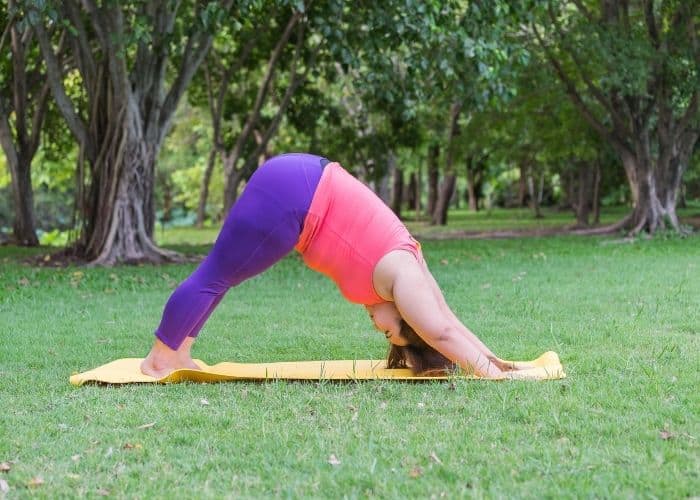
There’s truly nothing worse than walking into a yoga class and being the only woman who’s not a tightly Lululemon-clad spry Bohemian in a twisted pretzel shape.
Trust me, I’ve been there. Me in Spandex is not a pretty look.
Let’s face it, yoga isn’t the easiest thing to do for plus-size people at first, but that doesn’t mean you should forgo the activity altogether.
So, you’re probably wondering…
Can overweight people do yoga?
Yes, overweight people can do yoga. They may need to use yoga props at first to learn the positions and may have to modify some yoga poses, but yoga is for all shapes and sizes. Gentle yoga is best for obese people at first until they gain confidence in the poses to tackle them full-on.
If you haven’t tried yoga yet and you’re still not sold on the idea, don’t worry. This post will give you the inner strength you need to pick up a yoga mat and find your inner zen.
Besides addressing the central question, I’ll also go over:
- How you can start yoga if you’re overweight
- What kind of yoga is best for obesity
- How to modify yoga poses for overweight people
- Yoga tips for out-of-shape beginners
Let’s get started!
Table of Contents
Can Overweight People Do Yoga?
Don’t be silly!
Of course overweight people can do yoga. Yoga is just as much about the mind as it is the body.
As mentioned above, you may need to modify certain poses or use yoga props at first, but there’s no reason why without commitment and practice, you can be a yogi.
Don’t believe me?
Here are some plus-size yogis you can check out on Instagram:
Don’t get discouraged at first if you can’t do all the poses as everyone else in the room. If it helps, you can meet with the instructor of the yoga class in advance and discuss your concerns.
It’s not a bad idea to practice poses by yourself in a comfortable environment so you can learn the basics before doing yoga in public.
One thing to be aware of is that if you’re plus-size, the traditional yoga mat may not be suitable with your body. You should look for wider yoga mats that can accommodate all your curves.
If you want to do yoga, I’m confident you can.
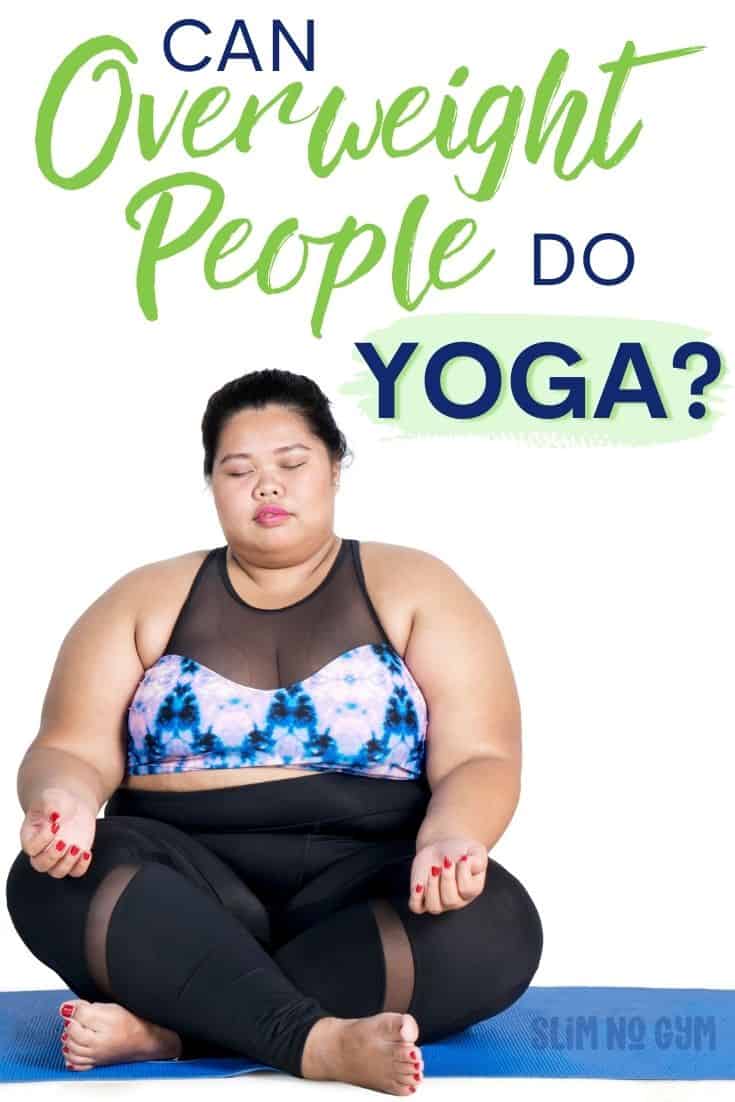
How Do I Start Yoga If I’m Overweight?
Great question!
As I mentioned above, you’ll want to pick up a yoga mat that’s wider (and perhaps a little thicker for support).
Once you do that, start doing simple poses. You can go to YouTube for tutorials so you can see exactly how they’re supposed to be done.
See if you can do those poses as is, but don’t push it. This will provide a benchmark for what you can accomplish without any supports, modifications, or props.
Once you’ve reached your beginning limits, you’ll want to know the following:
- Which yoga is best for obesity?
- How to modify yoga poses for overweight people
Let’s go over those in a bit more detail!
Which Yoga is Best for Obesity?
You might find that some styles of yoga suit your body type better than others.
While I truly believe that weight shouldn’t inhibit you when it comes to yoga, it’s certainly safe to want to start with more gentle or passive types of yoga.
Here are a few you may find useful:
- Yin: this style of yoga, done mostly in a sitting or reclining position, relies on passive poses that work with your own body weight to improve strength and flexibility
- Kripalu: this style of passive yoga focuses on relaxation and meditation to promote mental health as an overall part of well-being
- Savasana: this style of yoga, known as the “dead man’s pose” is the full embodiment of relaxation and surrender where you have your legs outstretched on the floor with your eyes closed while you focus on your breathing
If you want to start with more active yoga poses, go for it!
Just don’t be disappointed if you can’t do the pose entirely correctly at the beginning. Continue to work on it until you feel confident.
How to Modify Yoga Poses for Overweight People
The big goal throughout this process is to feel:
- Emotionally supported
- Physically safe
- Comfortable
If you want to modify yoga poses to accommodate your weight, then you should consider refraining from some activities that may cause physical discomfort.
This includes:
- Interlocking your hands behind your back
- Folding your body forward
- Rotating between standing and floor yoga poses quickly
- Standing hip-width distance
When doing yoga as a plus-size person, you have to understand that gaining flexibility and mobility is something to work towards over time.
Weight-Friendly Tip
If you’re overweight and doing yoga for the first time, it’s highly likely that you’re doing poses your body never thought it would have to contort into. Because of a sedentary lifestyle, your body has built up adipose tissue, which prevents your mobility. If this sounds like you, you should focus on yoga poses that position the limbs and torso in three planes to gain flexibility without having to uncomfortably hold or fold your body.In the beginning, focus on simpler poses that can help you lose weight and then you’ll feel more confident with tackling more challenging poses.
If you feel embarrassed, you’re more likely to stop.
So, modify the positions as you need so that you continue to do yoga.
5 Yoga Tips for Out-of-Shape Beginners
If you’re an out-of-shape beginner to yoga like I was when I first started, then there are a few things you should probably know so you don’t physically strain yourself at your first attempt.
They are:
- Stick to primarily upright asanas
- Use yoga props
- Set the pace yourself
- Stand wider to find your center
- Try new things and don’t get stuck
Let’s explore these a little more!
1. Stick to Primarily Upright Asanas
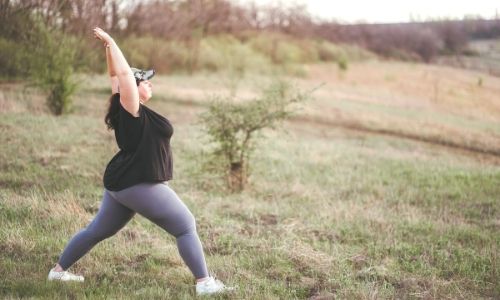
You’d be surprised at how long you can sustain upright yoga for.
What makes you out of breath is having to rapidly change between floor yoga and upright yoga.
Seated postures such as the butterfly or forward folds will be challenging for you, so stick to upright yoga poses that require movement of the:
- Arms
- Torso
- Legs
A great pose to try out first is the mountain pose.
Here’s what you do:
- Stand up straight
- Put your legs hip-width apart (we’ll go over later how to find this distance for you)
- Rest your hands comfortably at your side
- Inhale deeply as you raise your arms straight up to your ears, with the palms facing each other as you reach toward the sky
If you’ve followed along, congrats!
You’ve just done yoga and I have a feeling you’ll keep doing it.
2. Use Yoga Props
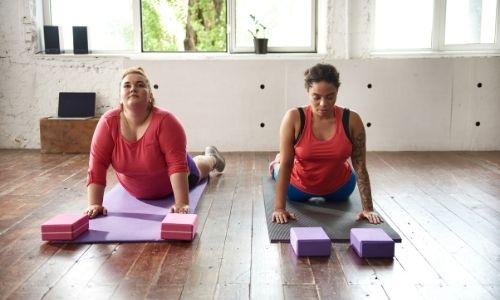
It’s perfectly okay to admit that you might need some help when it comes to modifying the poses to fit your body.
Here are a few props you might want to try out:
- Balance ball
- Yoga blocks
- Chair
- Harness
What these do is give you support in different areas so your weight doesn’t encumber you.
If you’re not sure how to use these props, then talk to the yogi in advance of a session so you feel confident. It’s perfectly okay to be familiar with the various props so you don’t go into a class with others being unable to do all the poses.
3. Set the Pace Yourself

If you’re in a fast-paced yoga class and unable to keep up, it can be so embarrassing.
If you can’t do all the poses, then just do the ones you can do.
You set the pace, not anyone else. If you’re just practicing at home, then take your time. If it takes you 15 minutes to change poses, then so be it.
Passing out because you forget to breathe or overstretching and falling are not ideal ways to kick off the first time you try out yoga.
You’ll get better with time. I promise.
4. Stand Wider to Find Your Center
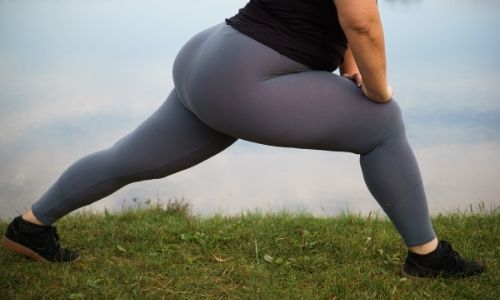
I mentioned earlier how you should avoid standing at hip-width if someone tells you to.
Hip-width distance refers to standing with your legs as far apart as the distance between your hips is.
Unfortunately, for overweight people, it can be difficult to distinguish where your actual hip is. There’s no reason to be embarrassed by this.
Weight-Friendly Tip
Unless a yoga instructor is overweight, they may be insensitive to the limitations of overweight and plus-size students. Anytime you heard the instruction “Stand hip-width distance,” think “Place your feet a comfortable distance away from each other so that you feel stable and supported.”Putting your legs hip-width distance apart as an overweight person doesn’t account for your larger thighs. It can be quite uncomfortable or feel tense to keep your legs close together.
So, stand far enough apart so you feel balanced and you won’t feel left out.
5. Try New Things and Don’t Get Stuck
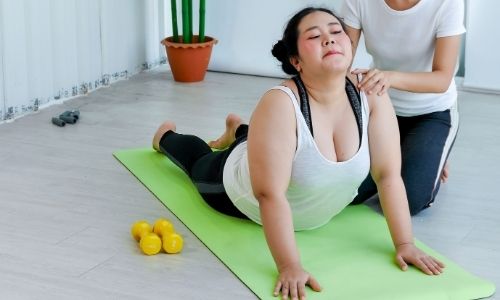
It can be very easy to get into a rut thinking that your weight is limiting your range of motions and potential yoga asanas.
Don’t fall into that trap!
Once you feel confident with simpler poses like the tree and mountain poses, try things more difficult. Try seated yoga. Try yoga with a trapeze.
If you’re concerned you’ll injure yourself, then express that to a yoga instructor in advance of a session. Say you want to try new things but that you need coaching throughout it.
As I said before, go at your own pace, but at some point, you’ll need to try new things or you’ll get bored of doing the same things over and over again.
For example, if you were using props to support yourself, try weaning yourself off the props.
Each day, commit to trying something differently so that you’re constantly improving how adept you are at yoga, regardless of your weight.
Frequently Asked Questions
I wouldn’t be shocked if you questions!
I had about a million running through my head when I tried yoga for the first time.
Here are some common ones I thought about:
- Can you do yoga if you’re fat?
- Is yoga good for plus-size people?
- How do I change my yoga poses for bigger bodies?
- Can you get in shape just by doing yoga?
Let’s answer those pressing questions so you can get back to doing yoga.
1. Can You Do Yoga If You’re Fat?
Yes, absolutely!
This is relatively similar to the question I addressed earlier, which was “can overweight people do yoga?”
I’ll copy my answer below in case you missed it.
Yes, fat people can do yoga. They may need to use yoga props at first to learn the positions and may have to modify some yoga poses, but yoga is for all shapes and sizes. Gentle yoga is best for obese people at first until they gain confidence in the poses to tackle them full-on.
If that doesn’t answer your question, then clarify it in the comments below.
2. Is Yoga Good for Plus-Size People?
Yes, yoga is great for plus-size people!
In a study published in The Journal of Alternative and Complementary Medicine, researchers concluded that yoga may be as effective as or better than exercise at improving a variety of health-related outcomes.
Yoga isn’t just about your physical body, though. It’s about the mind, too.
Performing yoga can help plus-sized people feel confident in their bodies and understand how to move them better so they don’t feel embarrassed.
3. How Do I Change My Yoga Poses for Bigger Bodies?
As I mentioned above, it’s quite simple to modify yoga poses for bigger bodies.
Here are some things you should AVOID:
- Interlocking your hands behind your back
- Folding your body forward
- Rotating between standing and floor yoga poses quickly
- Standing hip-width distance
And, here are some things you should TRY:
- Stick to primarily upright asanas or modify them to sitting in a chair
- Use yoga props for support
- Stand wider to find your center
Once you start doing yoga, you’ll learn what your comfort level is.
Try to push that ever so slightly each day.
4. Can You Get in Shape Just By Doing Yoga?
Yoga is a great way to gain mobility and lean muscles.
A study published in the International Journal of Yoga Therapy concluded that a kripalu yoga-based, residential weight loss program may foster:
- Psychological well-being
- Improved nutrition behaviors
- Weight loss
Ultimately, what they found is that the only way to truly see improvements is by putting in the work and doing it consistently.
Yoga can make a great addition to your exercise regime and can help center you, but you should try other things to diversify your workouts.
Conclusion
In this post, I answered the big question…
“Can overweight people do yoga?”
The answer was a resounding YES.
You may need to modify certain poses or use yoga props at first, but there’s no reason why without commitment and practice, overweight people can be yogis.
I also discussed:
- How you can start yoga if you’re overweight
- What kind of yoga is best for obesity
- How to modify yoga poses for overweight people
- Yoga tips for out-of-shape beginners
Do you have any more questions? Are you excited to start doing yoga?
Let us know in the comments below and keep us up to date on how you you’re achieving your dream body.
To your weight-loss success!

